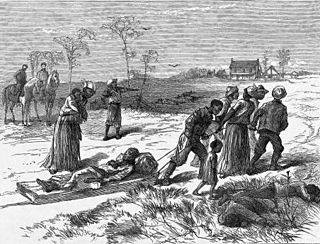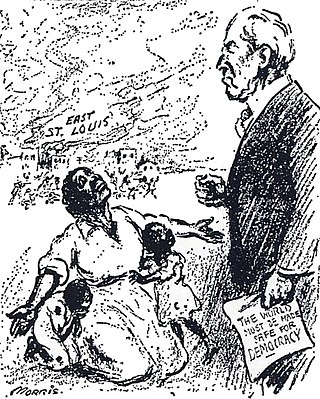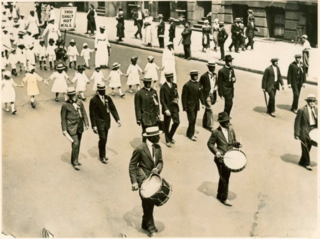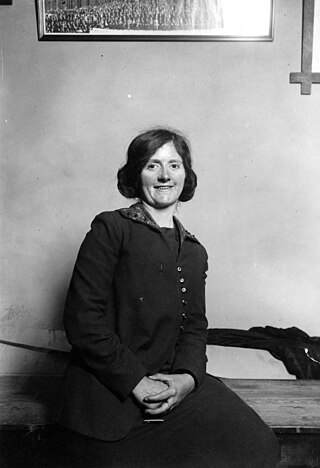In the broader context of racism in the United States, mass racial violence in the United States consists of ethnic conflicts and race riots, along with such events as:

The Tulsa race massacre, also known as the Tulsa race riot or the Black Wall Street massacre, was a two-day-long white supremacist terrorist massacre that took place between May 31 and June 1, 1921, when mobs of white residents, some of whom had been appointed as deputies and armed by city government officials, attacked black residents and destroyed homes and businesses of the Greenwood District in Tulsa, Oklahoma. The event is considered one of the worst incidents of racial violence in American history. The attackers burned and destroyed more than 35 square blocks of the neighborhood—at the time one of the wealthiest black communities in the United States, colloquially known as "Black Wall Street".

Rebecca Ann Felton was an American writer, politician, white supremacist, and slave owner who was the first woman to serve in the United States Senate, serving for only one day. She was a prominent member of the Georgia upper class who advocated for prison reform, women's suffrage and education reform. Her husband, William Harrell Felton, served in both the United States House of Representatives and the Georgia House of Representatives, and she helped organize his political campaigns. Historian Numan Bartley wrote that by 1915 Felton "was championing a lengthy feminist program that ranged from prohibition to equal pay for equal work yet never accomplished any feat because she held her role because of her husband."

The Scottsboro Boys were nine African American male teenagers accused in Alabama of raping two white women in 1931. The landmark set of legal cases from this incident dealt with racism and the right to a fair trial. The cases included a lynch mob before the suspects had been indicted, all-white juries, rushed trials, and disruptive mobs. It is commonly cited as an example of a legal injustice in the United States legal system.

Ida Bell Wells-Barnett was an American investigative journalist, educator, and early leader in the civil rights movement. She was one of the founders of the National Association for the Advancement of Colored People (NAACP). Wells dedicated her career to combating prejudice and violence, and advocating for African-American equality—especially that of women.

Alice Stokes Paul was an American Quaker, suffragist, feminist, and women's rights activist, and one of the foremost leaders and strategists of the campaign for the Nineteenth Amendment to the U.S. Constitution, which prohibits sex discrimination in the right to vote. Paul initiated, and along with Lucy Burns and others, strategized events such as the Woman Suffrage Procession and the Silent Sentinels, which were part of the successful campaign that resulted in the amendment's passage in August 1920.

The Colfax massacre, sometimes referred to as the Colfax riot, occurred on Easter Sunday, April 13, 1873, in Colfax, Louisiana, the parish seat of Grant Parish. An estimated 62–153 Black militia men were murdered while surrendering to a mob of former Confederate soldiers and members of the Ku Klux Klan. Three white men also died during the confrontation.

The Rosewood massacre was a racially motivated massacre of black people and the destruction of a black town that took place during the first week of January 1923 in rural Levy County, Florida, United States. At least six black people were killed, but eyewitness accounts suggested a higher death toll of 27 to 150. In addition, two white people were killed in self-defense by one of the victims. The town of Rosewood was destroyed in what contemporary news reports characterized as a race riot. Florida had an especially high number of lynchings of black men in the years before the massacre, including the lynching of Charles Strong and the Perry massacre in 1922.

The National Woman's Party (NWP) was an American women's political organization formed in 1916 to fight for women's suffrage. After achieving this goal with the 1920 adoption of the Nineteenth Amendment to the United States Constitution, the NWP advocated for other issues including the Equal Rights Amendment. The most prominent leader of the National Woman's Party was Alice Paul, and its most notable event was the 1917–1919 Silent Sentinels vigil outside the gates of the White House.

The East St. Louis massacre was a series of violent attacks on African Americans by white Americans in East St. Louis, Illinois between late May and early July of 1917. These attacks also displaced 6,000 African Americans and led to the destruction of approximately $400,000 worth of property. They occurred in East St. Louis, an industrial city on the east bank of the Mississippi River, directly opposite the city of St. Louis, Missouri. The July 1917 episode in particular was marked by white-led violence throughout the city. The multi-day rioting has been described as the "worst case of labor-related violence in 20th-century American history", and among the worst racial riots in U.S. history.

The New Orleans Massacre of 1866 occurred on July 30, when a peaceful demonstration of mostly Black Freedmen was set upon by a mob of white rioters, many of whom had been soldiers of the recently defeated Confederate States of America, leading to a full-scale massacre. The violence erupted outside the Mechanics Institute, site of a reconvened Louisiana Constitutional Convention. According to the official report, a total of 38 were killed and 146 wounded, of whom 34 dead and 119 wounded were Black Freedmen. Unofficial estimates were higher. Gilles Vandal estimated 40 to 50 Black Americans were killed and more than 150 Black Americans wounded. Others have claimed nearly 200 were killed. In addition, three white convention attendees were killed, as was one white protester.

The Springfield race riot of 1908 consisted of events of mass racial violence committed against African Americans by a mob of about 5,000 white Americans and European immigrants in Springfield, Illinois, between August 14 and 16, 1908. Two black men had been arrested as suspects in a rape, and attempted rape and murder. The alleged victims were two young white women and the father of one of them. When a mob seeking to lynch the men discovered the sheriff had transferred them out of the city, the whites furiously spread out to attack black neighborhoods, murdered black citizens on the streets, and destroyed black businesses and homes. The state militia was called out to quell the rioting.

The 1906 Atlanta Race Massacre, also known as the 1906 Atlanta Race Riot, was an episode of mass racial violence against African Americans in the United States in September 1906. Violent attacks by armed mobs of White Americans against African Americans in Atlanta, Georgia, began after newspapers, on the evening of September 22, 1906, published several unsubstantiated and luridly detailed reports of the alleged rapes of 4 local women by black men. The violence lasted through September 24, 1906. The events were reported by newspapers around the world, including the French Le Petit Journal which described the "lynchings in the USA" and the "massacre of Negroes in Atlanta," the Scottish Aberdeen Press & Journal under the headline "Race Riots in Georgia," and the London Evening Standard under the headlines "Anti-Negro Riots" and "Outrages in Georgia." The final death toll of the conflict is unknown and disputed, but officially at least 25 African Americans and two whites died. Unofficial reports ranged from 10–100 black Americans killed during the massacre. According to the Atlanta History Center, some black Americans were hanged from lampposts; others were shot, beaten or stabbed to death. They were pulled from street cars and attacked on the street; white mobs invaded black neighborhoods, destroying homes and businesses.
The Rape Crisis Movement began in the 1970s when activists and members of counter-culture began to openly confront or breaking the silence on the issue of rape. Movement members and supporters brought the issue to the public commons by vocalizing the suffering that occurs a result of rape. At the time the movement was considered radical because it destabilized the existing social norms. The movement was concerned with the experiences of women and is credited with the legitimization of victim claims. Prior to the movement, rape victims involved in legal trials were subjected to further victimization at the hands of defense attorneys and the court system. Victims' rights and protection became a focus as a result of the movement.

The Memphis massacre of 1866 was a series of violent events that occurred from May 1 to 3, 1866 in Memphis, Tennessee. The racial violence was ignited by political and social racism following the American Civil War, in the early stages of Reconstruction. After a shooting altercation between white policemen and black veterans recently mustered out of the Union Army, mobs of white residents and policemen rampaged through black neighborhoods and the houses of freedmen, attacking and killing black soldiers and civilians and committing many acts of robbery and arson.

Recy Taylor was an African-American woman from Abbeville in Henry County, Alabama. She was born and raised in a sharecropping family in the Jim Crow era Southern United States. In the 1940s, Taylor's refusal to remain silent about her rape by white men led to organizing in the African-American community for justice and civil rights.

The anti-lynching movement was an organized political movement in the United States that aimed to eradicate the practice of lynching. Lynching was used as a tool to repress African Americans. The anti-lynching movement reached its height between the 1890s and 1930s. The first recorded lynching in the United States was in 1835 in St. Louis, when an accused killer of a deputy sheriff was captured while being taken to jail. The black man named Macintosh was chained to a tree and burned to death. The movement was composed mainly of African Americans who tried to persuade politicians to put an end to the practice, but after the failure of this strategy, they pushed for anti-lynching legislation. African-American women helped in the formation of the movement, and a large part of the movement was composed of women's organizations.

In Forsyth County, Georgia, in September 1912, two separate alleged attacks on white women in the Cumming area resulted in black men being accused as suspects. First, a white woman reportedly awoke to find a black man in her bedroom; then days later, a white teenage girl was beaten and raped, later dying of her injuries.

Mary Hannah Williams Thomas O'Neal was a Welsh-born American labor activist who wrote the only eyewitness memoir of the Ludlow Massacre, part of the Colorado Coalfield War.

The Ellenton riot or Ellenton massacre occurred in September 1876 and took place in South Carolina in the United States. The massacre was preceded by a series of civil disturbances earlier that year following tensions between the Democratic Party and the Republicans. Author Mark M. Smith concluded that there was one white and up to 100 blacks killed, with several white people wounded. While John S. Reynolds and Alfred B. Williams cite much lower numbers.


















